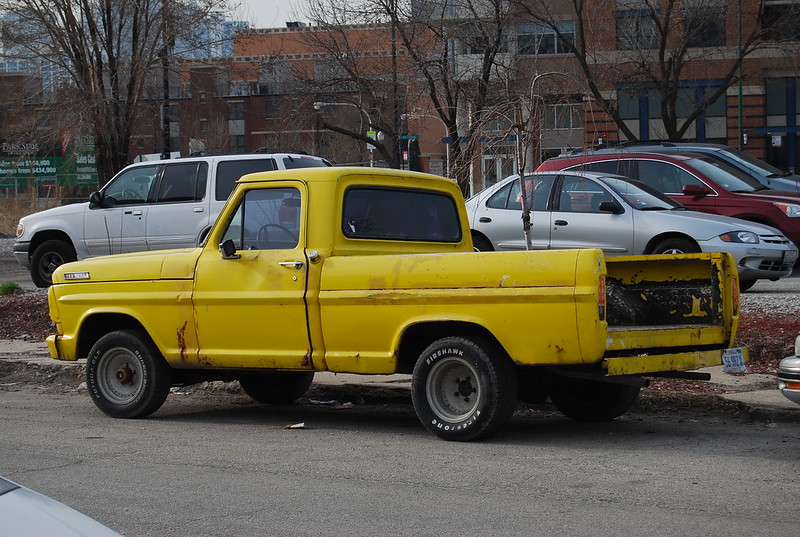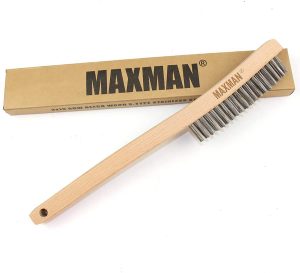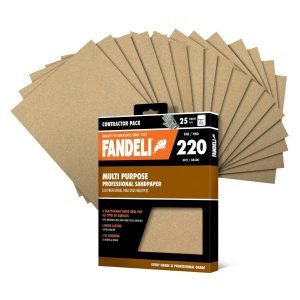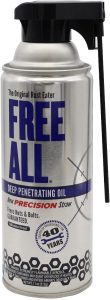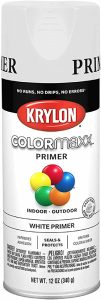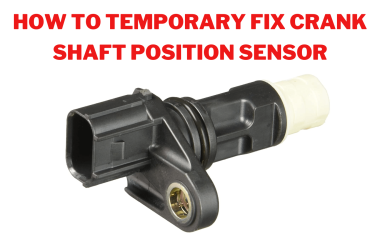Most people buy a pickup truck to carry different stuff in the truck bed daily. And driving a pickup truck in misty environment exposes the truck bed to rust. Rust is a common problem for truck beds, and it can form due to environmental factors like moisture, salt, and road chemicals or simply because of age. Rust usually starts as small areas of surface discoloration that quickly grow into patches or sheets of rust if left untreated. That’s why I am writing this comprehensive post to show you how to fix a rusted truck bed.
Fortunately, there are a few ways you can fix a rusted truck bed and restore it to its previous condition. One way is to use chemical rust removers or wire brushes, and these products can be applied directly onto the rusty areas and then scraped off with a stiff brush or sandpaper. These chemicals are also available in spray cans, making them easy to apply evenly over large surfaces.
If the rust has spread deeply into the metal surface of your truck bed, you may need to use more aggressive methods such as grinding and welding. Grinding involves using an angle grinder or sander to remove rust and expose the clean metal underneath. At the same time, welding requires attaching new pieces of steel over patches of corrosion-affected areas.
Table of Contents
How to fix a rusted truck bed
- Identifying the Severity of Rust Damage
- Preparation for Repairing a Rusted Truck Bed
- Use Wire Brush To clean the rust
- Use Sandpaper for the Remaining Rust
- Apply Chemical Rust Remover Or Rust Restorer
- Metal sheets to repair severely damaged areas
- Apply Body Filler
- Apply Primer
- Apply Paint
Identifying the Severity of Rust Damage
Identifying the severity of rust damage is also important for rust repair. Performing a rust test can help assess the extent of rust damage and determine what repair techniques are needed. To perform a rust test, scrape away any paint or rust off the surface with a blade and look for signs of rust underneath. If rust has spread deep into the metal, it’s recommended that you take your truck for professional repairs, as further action may be necessary.
Types of rust damage
Types of rust damage can also differ. If rust has only affected the surface, you can repair it with rust removal products or a rust converter. On the other hand, if rust has spread through multiple layers of metal, welding, and grinding will be needed to restore your truck bed to its former glory.
Preparation for Repairing a Rusted Truck Bed
Proper preparation is also essential when performing rust repair on a vehicle. Make sure to clean the rust-affected area as much as possible before attempting any rust removal or repair process. A good cleaning will help remove dirt and debris while also providing a better surface to work with. Additionally, it’s recommended that you wear protective gear such as gloves, safety glasses, and a mask when handling rust removers and other corrosive chemicals.
Rust can be an unsightly problem for truck beds, but there are several ways to fix it. Whether you use rust removal products, grind and weld, or take your truck for professional repairs, rust repair can help restore your vehicle to its original condition. With proper preparation, rust repair can be an easy and cost-effective solution for rust damage on your truck bed.
Use Wire Brush To clean the rust
Cleaning rust from your truck bed is important to maintain its condition. A wire brush is a great tool for rust repair on your truck bed. It can help you remove rust and corrosion buildup that can cause damage or deterioration to the truck’s paint, metal, and other parts.
To start rust repair with a wire brush, begin by brushing away large chunks of rust. Brushing with a wire brush should loosen the smaller pieces of rust that may be stuck in crevices or hard-to-reach areas. Use the wire brush in a circular motion while holding the bristles flat against the surface of the truck bed to ensure all rust particles are removed completely.
Buy on Amazon
Use Sandpaper for the Remaining Rust
Sandpaper is an effective rust repair tool for removing rust particles that the wire brush may have missed. Begin sanding with medium to coarse grit paper, and gradually increase coarseness as needed. Work slowly and steadily until all rust has been removed from the truck bed. Be sure to use high-quality sandpaper and replace it regularly as it wears down.
Buy On Amazon
Wash Away the Dust and Sediment
Once removal is complete, use a hose to wash away any remaining dust or rust particles. Make sure to reach all areas of the truck bed with the hose to ensure no rust remains. Use a cloth to pat down and dry the truck bed before rust-proofing.
Apply Chemical Rust Remover Or Rust Restorer
After washing away rust flakes and dust, it’s time to tackle the rust. A rust remover or restorer should be used to repair rusted truck bed parts. Rust removers are chemical solutions that break down rust and help make it easier to remove from surfaces. Rust restorers use chemicals to convert rust back into a protective iron oxide layer which helps protect against further rusting of the metal part.
When applying these chemicals, following manufacturer recommendations and safety instructions is important to ensure proper application and the best results. Ensure you wear all necessary protective gear, such as gloves, eyewear, and masks, when handling chemicals like this. Once the rust has been removed or converted by the chemical solution, you can then scrub away any remaining rust particles with a stiff brush or steel wool.
Buy On Amazon
Metal sheets to repair severely damaged areas
If some areas are severely damaged due to rust, you may need to replace the metal of your truck bed. You can purchase sheets of rust repair material such as diamond plate steel or aluminum from most hardware stores. After cutting and shaping the rust repair material to fit the damaged area, use a rust inhibitor product on the entire surface.
Finally, use rust-resistant screws or rivets to securely attach the rust repair material. It’s important to ensure that any rust inhibitor product you choose is safe for use around food items; some rust inhibitors contain lead particles which can be dangerous if ingested.
Apply Body Filler
Applying body filler is one of the most important steps in rust repair for a truck bed. After removing rust and patching the affected, it is best to apply body filler. Body filler will help fill any rust holes and prevent further rusting from occurring. It’s best to use an epoxy-based body filler designed specifically for rust repairs, as it will provide better adhesion and longer durability. Apply the filler according to package instructions using a putty knife or other appropriate tool. Once dry, the rust repair area should be sanded until smooth and even.
Apply Primer
The next step in rust repair for your truck bed is to apply primer, ensuring that no rust returns in the future. Use a rust-inhibiting primer specifically designed for rusty surfaces; this type of primer will help prevent rust from forming on the repaired area. Apply a thin, even coat of rust-inhibiting primer and allow it to dry completely before continuing.
Buy On Amazon
Apply Paint
Once you have applied rust-inhibiting primer and allowed it to dry, you are ready to apply paint. It’s important that you use paint that is specifically designed for rust repair; this will ensure the best results. Use a brush or roller for larger rust repair areas and a spray can for smaller rust repair spots. Allow your newly painted truck bed to dry completely before using it again.
Follow above mentioned points if, you don’t know how to fix a rusted truck bed. I am pretty sure after following these steps; your truck bed will look like new.
Also Read: DIY Truck Bed Extender
Prevention of Future Rust Damage on a Truck Bed
Once rust repairs on a truck bed have been completed, it is important to take steps to prevent rust from occurring again. Several steps can be taken for rust prevention that, include:
- Cleaning and Waxing the Truck Bed Regularly – Cleaning and waxing the truck bed will help protect its surface from rust damage by removing dirt, moisture, and other elements found in the environment that can cause rust over time.
- Sealing Any Holes in the Truck Bed – If holes or cracks exist in the truck bed, these should be sealed with an appropriate sealant, such as epoxy or silicone. Sealing will help keep out water, which can lead to rust formation.
- Applying a Rust Preventative Coating – After cleaning and waxing, rust preventative coatings can help to keep the rust away. These rust preventatives come in many forms, such as spray-on rust-proof paints or rust converters that convert rust into a protective layer on the truck bed’s surface.
Following these steps will help ensure that your truck bed is free from rust for years. Taking the time to repair any rust damage now and taking preventative measures will save you time and money in the future when it comes to maintaining your truck bed.
Maintenance of a Repaired Truck Bed
Once you have rust-proofed and repaired your rusted truck bed, there are a few steps to take to ensure it remains rust-free and functioning properly. Regular inspection of the area is key; check the rust repair areas periodically for any signs of rust developing or any damage that may have been missed during the repair process. Additionally, it is important to regularly apply rust inhibitor or rust-proofing spray to the truck bed.
This will help protect against any further rusting or corrosion and preserve the integrity of your repair job. Finally, ensure that you keep the bed clean from dirt and debris by hosing off any buildup of mud or grime; this will also prevent rust by removing the moisture and dirt that rust needs to form. Following these steps will help maintain your rust-proofed truck bed for a long time.
Conclusion
Once you’ve examined the rust on your truck bed and taken the necessary steps to repair it, you should be able to enjoy a rust-free truck bed for many years. Remember that rust can quickly return if proper care is not taken, so make sure to inspect your truck bed regularly and take preventive measures such as waxing or painting to keep the rust away.
Taking these steps to repair a rusted truck bed will save you time and money in the long run by ensuring your truck can remain rust-free and look its best. With a little effort and some rust-repair materials, you can easily fix any rust damage on your truck bed. These few steps are answer to how to fix a rusted truck bed.
Frequently Asked Questions
Is investing in the restoration of a rusted truck bed worth it?
Investing in restoring a rusted truck bed can be worth it, depending on factors like the condition of the existing metal and any plans for future customization or use. If you’re looking to restore an old truck bed already in good condition, then investing in a complete restoration may not be necessary. However, if the existing metal is rusted, weak, or otherwise damaged, investing in a thorough restoration of the bed can add value to your truck and ensure it’s safe for use.
What causes rust on truck beds?
Rust on truck beds is primarily caused by exposure to moisture. Moisture from rain, snow, or even humidity can cause metal surfaces to corrode and form rust. This corrosion is accelerated if the vehicle’s bed doesn’t have a protective coating, such as paint or primer. Road salt and other de-icing chemicals can also contribute to metal corrosion and create an environment where rust thrives. Finally, leaving tools or objects in your truck bed can trap moisture, leading to rust over time.
How can I prevent rust on my truck bed?
Regularly washing your truck bed with mild detergent and water is one of the best ways to prevent rust. After washing, you should also dry it off completely to help reduce moisture buildup. Additionally, waxing your truck bed after a few days can create an extra layer of protection against the elements that can cause rust.
If you live in an area with snow or de-icing materials used on the roads, it is especially important to keep salt away from your truck bed, as this can encourage corrosion and rust formation. Keeping your truck covered when not in use and regularly checking for any signs of corrosion or rust can also help protect it from further damage.
Can I use regular paint to restore my rusted truck bed?
No, regular paint will not be sufficient to restore a rusted truck bed. Rust is a result of metal oxidation caused by exposure to moisture and oxygen, which makes the metal weak and prone to further damage. You’ll need to use a rust converter or primer specifically designed for your truck bed to repair rust.
These products chemically convert rust into an inert state so that it can be painted without further deterioration. You should also use an automotive-grade topcoat containing UV protectants to ensure long-lasting protection from the elements.
Which is the best homemade rust remover?
The best homemade rust remover is a mixture of equal parts white vinegar and baking soda. Simply mix the two ingredients together until they form a paste, then apply it to the rusted area with a brush or cloth. Let sit for an hour or up to overnight, then scrub off with a stiff brush or steel wool. If necessary, repeat the process until the rust is gone.
If you are dealing with more stubborn rust, add some lemon juice or hydrogen peroxide to the mixture for an extra boost. Add a few drops of dish soap for particularly tough stains to help loosen up the rust.





